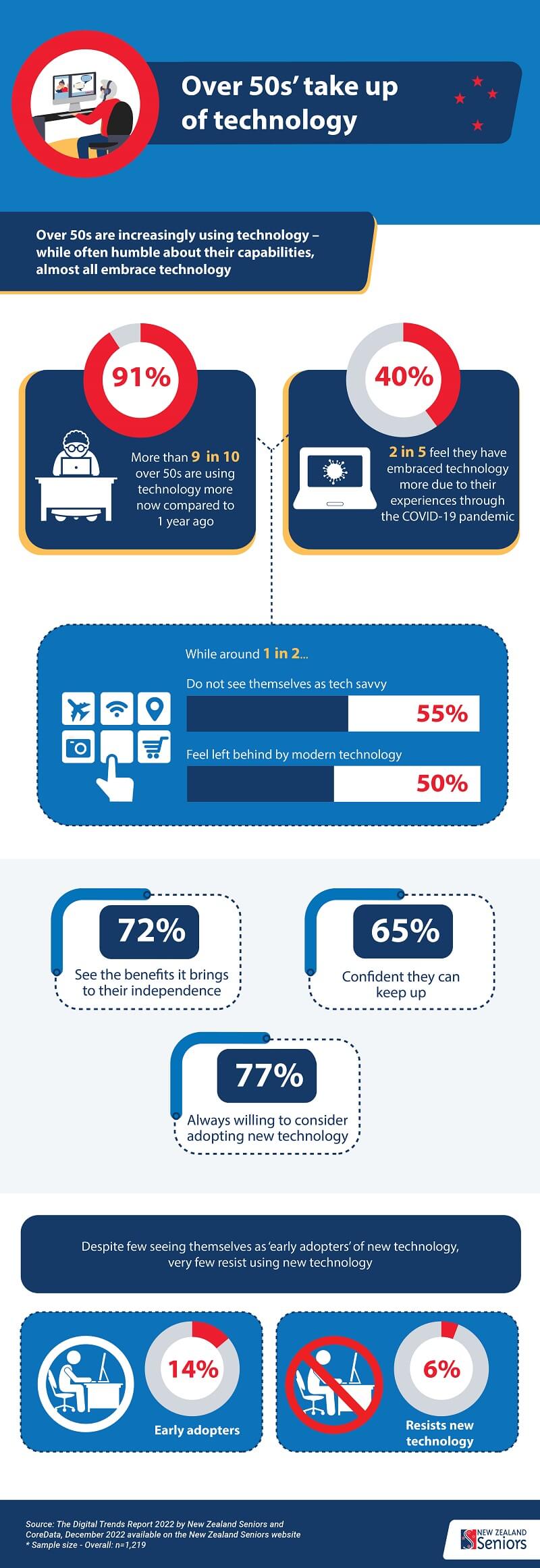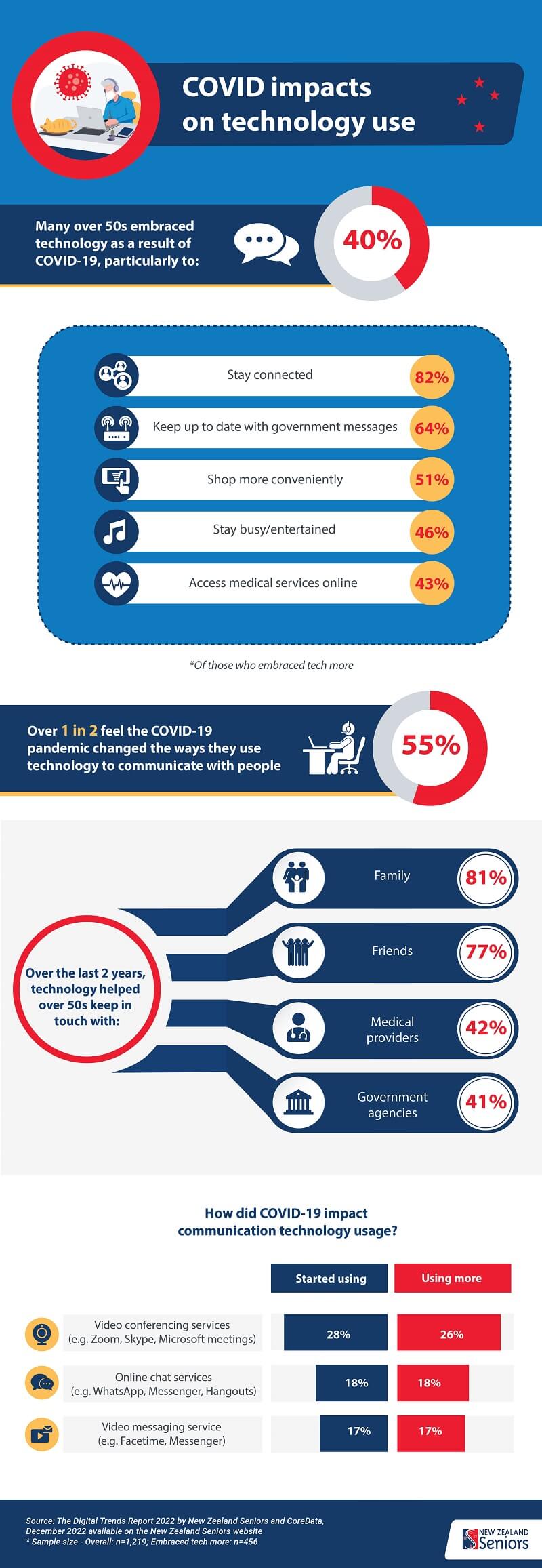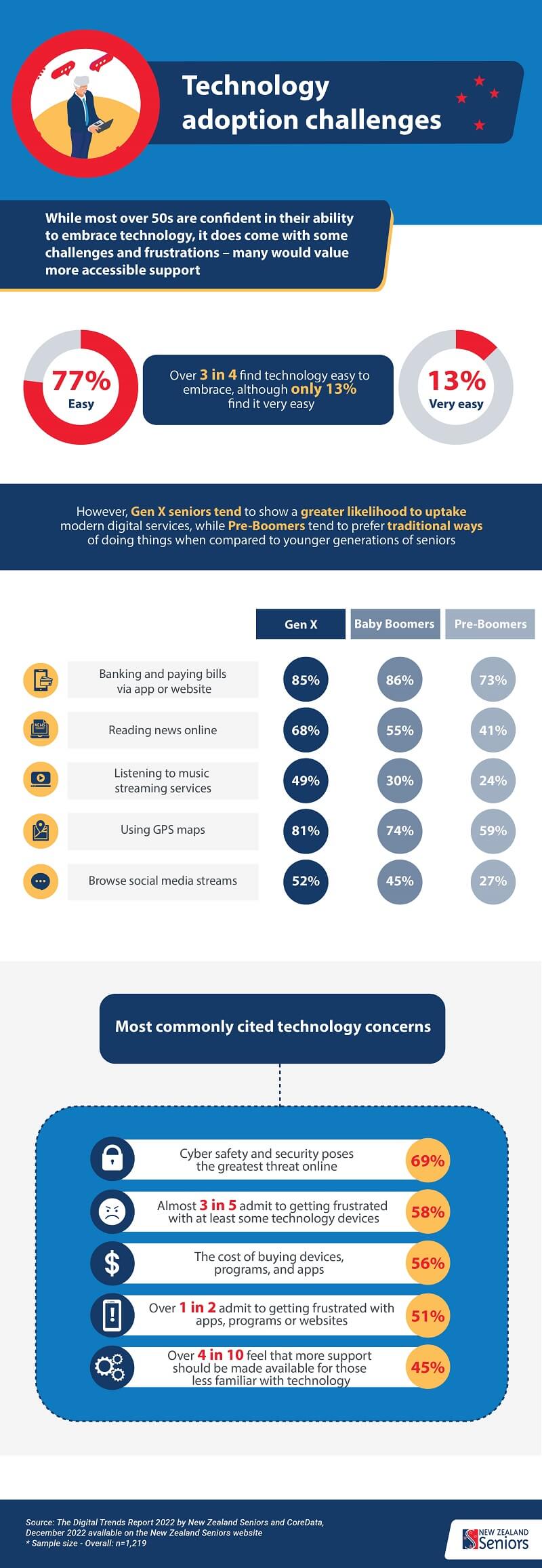The New Zealand Seniors Series: Digital Trends Report 2022
The pandemic may soon be a distant memory for most Kiwis, especially after the government scrapped mandatory restrictions, signalling to the rest of the world that our country is ready to move on.
However, the impact of the 900-odd days of COVID-19 still lingers in many aspects of our lives.
One change that resonates with our seniors’ community is how much more we have leaned on technology to navigate our day-to-day. For many of us, the pandemic marked a shift in our relationship with technology. Its ability to connect us with medical professionals, our workplaces, hobbies, and our loved ones has made us more accepting of its impact on our lives.
The Digital Trends 2022 Report forms part of the New Zealand Seniors Series, which explores the issues that matter most to our community. Surveying 1,129 New Zealanders over 50, this chapter explores our relationship with technology, including the opportunities, challenges, behaviours, and attitudes towards various types of technology.
COVID fast-tracked tech uptake
As seniors, we are optimistic, active, independent, and curious beings, and we value feeling connected to the world around us and our loved ones. Facing lockdowns and restrictions over the past few years created new barriers to enjoying life on our terms, and we opened our minds to new opportunities. Many of us embraced technology as a tool for connection at a time when our world was physically disconnected.
The latest data from the Digital Trends Report reveals that our technology usage has jumped due to our experiences through the COVID-19 pandemic, with 2 in 5 (40%) of us now embracing modern technology more than in pre-pandemic times. It makes sense that one of the most common reasons (82%) cited by seniors who adopted more technology had been the help it provides in staying connected, with over 4 in 5 (81%) of us agreeing that modern technology has helped us keep in touch with family over the last two years and nearly three-quarters (77%) of us agreeing that it has allowed us to remain connected with friends over the last 2 years.
In the same vein, COVID-19 has encouraged us to start using digital communication technologies, especially videoconferencing services (28%), online news and media consumption (22%), and online chat services (18%).
Beyond human connection, technology also offered us a means to stay across news updates/government updates about the pandemic (64%) and to shop more conveniently (51%) during the COVID-19 pandemic, mainly when restrictions made it tricky for us to manage grocery shopping all on our own meant while the one-person-per-household rule was in place.

Digital device’s best friend
The ease of running errands and completing ‘life admin’ more conveniently and from the comfort of our homes is another reason why some of us feel technology is becoming a more critical part of our lives. This was especially true when accessing essential services like banking was increasingly difficult during lockdowns when we were trying to reduce our risk of exposure by not leaving our homes more than needed.
One of the most common day-to-day uses of technology in our community is managing finances (64%), which explains why 4 in 5 (82%) of us agree that banking, finances and paying bills are essential functions for us to access with our devices – challenging the outdated stereotype that seniors still rely on cash or a cheque in-person at the bank.
With so many essential activities now accessible through our devices, it’s no wonder that those of us who use technology on a weekly basis spend, on average, 5.3 hours a day on them. In the wake of the pandemic, nearly half (48%) of us agree that it would be hard for us to manage without our digital technology devices, and a similar proportion of us (55%) agree that COVID-19 has changed how we use technology to communicate. In many ways, we have taken technology in our stride to make every day more enjoyable and to improve our physical, social and mental well-being by staying connected with loved ones and the community via messaging services (58%), social media (43%), and video call/conferencing (34%).

But human touch is still needed
While technology emerged as a great tool to overcome the barriers posed by the pandemic, it’s also clear that it wasn’t a silver bullet, particularly around healthcare.
The use of telemedicine during this time was a positive experience, given that almost 4 in 5 (79%) of us think there will be a significant increase in the use of technology to address our health needs in the future. However, on the flip side, over 7 in 10 (72%) of us view inadequate assessment or limit of treatments due to lack of physical contact as one of the greatest disadvantages of using telemedicine, followed by nearly 2 in 3 (64%) of us who miss having in-person interactions. Interestingly, despite our openness to technology in other aspects of our lives, 9 in 10 (94%) of us who check symptoms online before consulting with a doctor when they feel unwell, still trust a doctor to diagnose our health issues more than online resources.

Technology comes with challenges too
For all its strengths, the pandemic also revealed the challenges of embracing technology, with many of us waking up to the possible threats of an online presence.
With an abundance of scams circulating during the pandemic, particularly as digital communication became more frequent, it’s unsurprising as many as 4 in 5 (80%) of us are at least reasonably concerned about the safety of our private information online, with almost 1 in 5 (19%) extremely concerned. This is understandable, given that close to 4 in 5 (79%) of us have either been personally targeted or know of someone who has been scammed with the most common methods used in these scams being via email (55%) and over the phone (67%). Sadly, among those of us who have been victims of scams, 3 in 10 (31%) of us have lost money.
However, despite the danger lurking around, 3 in 4 (77%) of us are at least reasonably confident in our ability to keep our digital information confidential and secure.
According to the survey findings, the most commonly cited significant challenge of using technology are safety and security (69%), followed by understanding how it works (65%), the constant learning curve of keeping up with the change (61%) and the cost of devices, programs and apps (56%).

“Not everyone has access to the online world. Seniors, particularly those in the 85+ age group, are opting out of being online because they have trouble affording the devices and broadband connections,” said Karen Jansen-Billings, Chief Executive of Age Concern.
“Kiwi seniors are eager to learn. We must remember that older people have lived through so many changes and technological advancements in their lives; we need to support them with the right education and advice so they can also join online conversations. We must ensure there are alternative ways for people to access services offline. It should not be the only way seniors can get what they need.”
One thing’s for sure: digital technologies have affirmed a place in everyone’s lives, both young and young-at-heart. Over the past few years, we have demonstrated our open-mindedness to technology and shattered the old-fashioned stereotypes that have stuck around for far too long.

Stay tuned for the next chapter of the New Zealand Seniors Series. The above information has been sourced from The Digital Trends Report 2022, available here.
8 Dec 2022